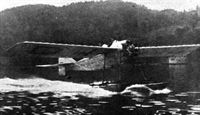
Ранние монопланы Blackburn
<...>
Продолжая работу над своим проектом, Блэкберн построил двухместную модификацию, получившую обозначение Type I, первый полет нового самолета состоялся в августе 1913 года. Оснащенный ротативным двигателем Gnome мощностью 80 л. с. Type I вы полнил множество полетов. За ним последовал другой Type I - одноместный самолет с тем же двигателем, а также появился "улучшенный" Type I. Он также часто поднимался в воздух и со временем был переделан в учебный гидросамолет со звездообразным двигателем Anzani для компании "Nothern Aircraft Со", использовавшей его на озере Виндермир. Многие пилоты школы авиации британского флота прошли базовый курс подготовки именно на этом "Наземно-морском моноплане" (Land/Sea Monoplane), а в апреле 1916 года самолет отправили в отставку.
В целом схожим с Type I был самолет "White Falcon", единственный двухместный моноплан с двигателем Anzani мощностью 100 л.с. Эта машина была построена для летчика-испытателя компании "Blackburn" У. Роуланда Динга в 1915 году, но дальнейшая ее судьба не известна.
- Описание
Фотографии
-
Aviation Historian 21 / N.Forder - The War of the Roses air race
Three examples of the Blackburn Type I were built: the "War of the Roses" two-seater owned by Dr M.G. Christie (the subject of the Flight report in December 1913); a single-seater with a single kingpost, and the Improved Type I, as seen here in 1914, fitted with a single kingpost and a smaller tailplane.
-
Aviation Historian 21 / N.Forder - The War of the Roses air race
Другие самолёты на фотографии: Avro Avro 504 - Великобритания - 1913
-
Aviation Historian 21 / N.Forder - The War of the Roses air race
A contemporary postcard showing the two contenders on the day of the race round Yorkshire on October 2, 1913. According to Flight, some 60,000 spectators turned up at Moortown to see the competitors off, despite the weather being less than ideal, with frequent bouts of mist causing problems throughout the day.
Другие самолёты на фотографии: Avro Avro 504 - Великобритания - 1913
-
Aviation Historian 21 / N.Forder - The War of the Roses air race
The Blackburn monoplane and Avro 504 prototype side by side, probably at Moortown before the start of the race. In July the following year Harold Blackburn used the same two-seater to open the first scheduled service in Britain, when he flew the first of his half-hourly single-passenger-carrying flights between Leeds and Bradford.
Другие самолёты на фотографии: Avro Avro 504 - Великобритания - 1913
-
Flight 1939-05 / Flight
A special fast 80 h.p. monoplane belonging to Dr. Christie (circa 1913).
-
Aviation Historian 17 / M.Parry - Major Horace Buss
Horace Buss aloft in the sole Blackburn Single-Seat Monoplane over Knavesmire, part of York racecourse, in June 1914. The aircraft, powered by a 50 h.p. Gnome engine, was put into storage upon the outbreak of war later that year, and was rediscovered by Richard Shuttleworth in 1938. It still flies today with the Shuttleworth Collection.
-
Aviation Historian 17 / M.Parry - Major Horace Buss
Horace Austen Buss poses in the cockpit of the Blackburn Monoplane shortly after having gained his Royal Aero Club Certificate in February 1913. Buss would become one of the early Royal Naval Air Service pioneer pilots. Although he is referred to in many sources as Harold Buss, he was most definitely a Horace!
-
Мировая Авиация 54
Land/Sea Monoplane хорошо нес службу, пока не разбился в Боунессе
-
Flight 1939-05 / Flight
The little mono-seaplane was used at the flying school on Lake Windermere from 1915 onwards.
-
Air Pictorial 1988-01 / M.Goodall - Flying from lake Windermere - 1909-1921 /Britain's Seaplane Pioneers/ (2)
The Blackburn Land/Sea Monoplane acquired by the Northern Aircraft school in 1915, seen at Hill of Oaks. Powered by a 100-h.p. Anzani, it had wingwarping for lateral control
-
Air Pictorial 1988-01 / M.Goodall - Flying from lake Windermere - 1909-1921 /Britain's Seaplane Pioneers/ (2)
Another view of the Blackburn at Hill of Oaks. As well as a trainer it was used by Rowland Ding as his personal runabout
-
Aeroplane Monthly 1983-10 / L.Coombs - Cockpits of the RAF (1)
The “roomy and comfortable” cockpit of the 1914 Blackburn Type I, shown in the contemporary Flight sketch, was equipped with a wheel for wing-warping and a separate rudder bar.
-
Aviation Historian 21 / N.Forder - The War of the Roses air race
THE 80 H.P. BLACKBURN MONOPLANE - Plan, side and front elevations to scale.
- Фотографии












